2017 NISSAN MICRA mileage
[x] Cancel search: mileagePage 202 of 318
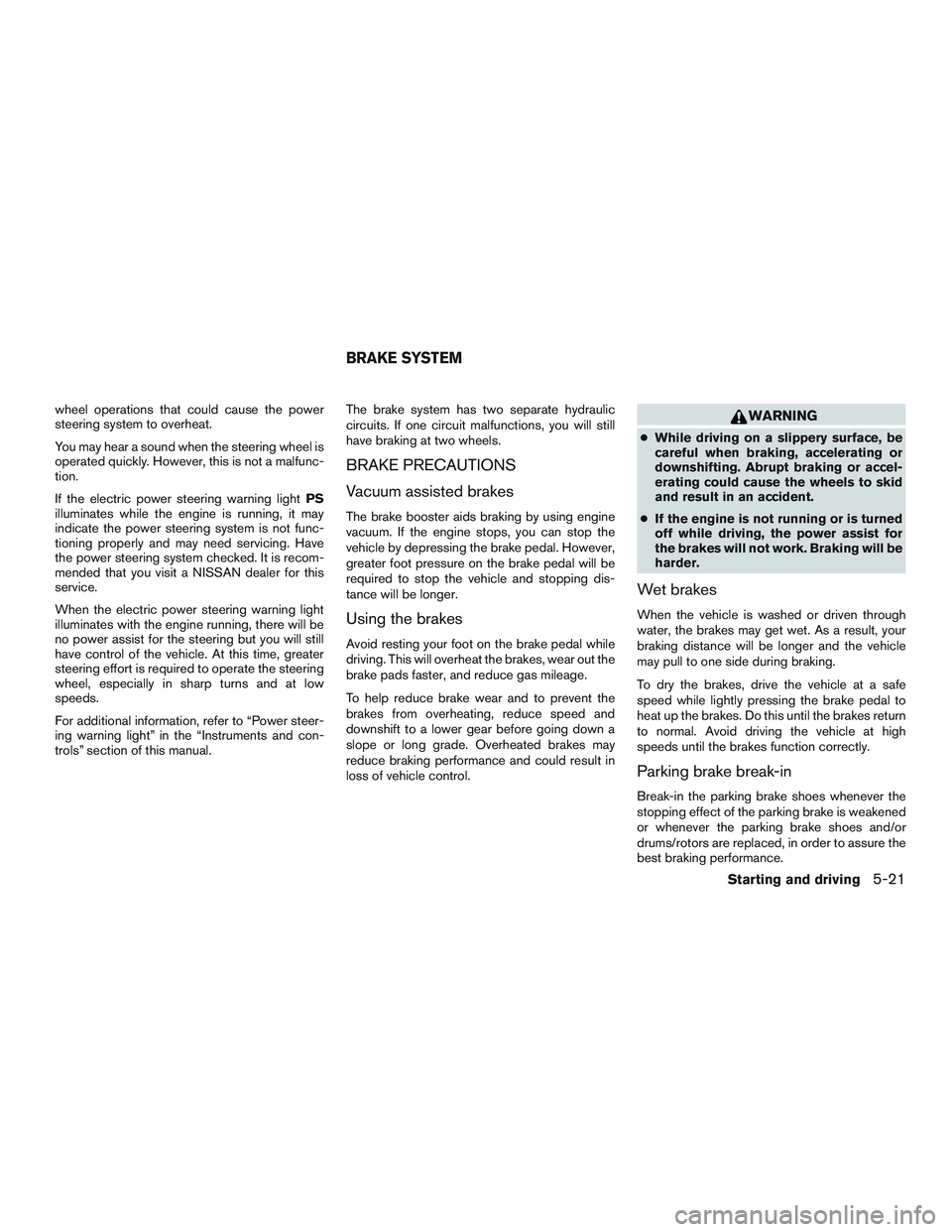
wheel operations that could cause the power
steering system to overheat.
You may hear a sound when the steering wheel is
operated quickly. However, this is not a malfunc-
tion.
If the electric power steering warning lightPS
illuminates while the engine is running, it may
indicate the power steering system is not func-
tioning properly and may need servicing. Have
the power steering system checked. It is recom-
mended that you visit a NISSAN dealer for this
service.
When the electric power steering warning light
illuminates with the engine running, there will be
no power assist for the steering but you will still
have control of the vehicle. At this time, greater
steering effort is required to operate the steering
wheel, especially in sharp turns and at low
speeds.
For additional information, refer to “Power steer-
ing warning light” in the “Instruments and con-
trols” section of this manual. The brake system has two separate hydraulic
circuits. If one circuit malfunctions, you will still
have braking at two wheels.
BRAKE PRECAUTIONS
Vacuum assisted brakes
The brake booster aids braking by using engine
vacuum. If the engine stops, you can stop the
vehicle by depressing the brake pedal. However,
greater foot pressure on the brake pedal will be
required to stop the vehicle and stopping dis-
tance will be longer.
Using the brakes
Avoid resting your foot on the brake pedal while
driving. This will overheat the brakes, wear out the
brake pads faster, and reduce gas mileage.
To help reduce brake wear and to prevent the
brakes from overheating, reduce speed and
downshift to a lower gear before going down a
slope or long grade. Overheated brakes may
reduce braking performance and could result in
loss of vehicle control.
WARNING
●
While driving on a slippery surface, be
careful when braking, accelerating or
downshifting. Abrupt braking or accel-
erating could cause the wheels to skid
and result in an accident.
● If the engine is not running or is turned
off while driving, the power assist for
the brakes will not work. Braking will be
harder.
Wet brakes
When the vehicle is washed or driven through
water, the brakes may get wet. As a result, your
braking distance will be longer and the vehicle
may pull to one side during braking.
To dry the brakes, drive the vehicle at a safe
speed while lightly pressing the brake pedal to
heat up the brakes. Do this until the brakes return
to normal. Avoid driving the vehicle at high
speeds until the brakes function correctly.
Parking brake break-in
Break-in the parking brake shoes whenever the
stopping effect of the parking brake is weakened
or whenever the parking brake shoes and/or
drums/rotors are replaced, in order to assure the
best braking performance.
BRAKE SYSTEM
Starting and driving5-21
Page 278 of 318

Radiator and hoses:Check the front of the
radiator and clean off any dirt, insects, leaves,
etc., that may have accumulated. Make sure the
hoses have no cracks, deformation, rot or loose
connections.
Underbody: The underbody is frequently ex-
posed to corrosive substances such as those
used on icy roads or to control dust. It is very
important to remove these substances from the
underbody, otherwise rust may form on the floor
pan, frame, fuel lines and exhaust system. At the
end of winter, the underbody should be thor-
oughly flushed with plain water, in those areas
where mud and dirt may have accumulated. For
additional information, refer to the “Appearance
and care” section of this manual.
Windshield-washer fluid*: Check that there is
adequate fluid in the reservoir. The following descriptions are provided to give
you a better understanding of the scheduled
maintenance items that should be regularly
checked or replaced. The maintenance schedule
indicates at which mileage/time intervals each
item requires service.
In addition to scheduled maintenance, your ve-
hicle requires that some items be checked during
normal day-to-day operation. For additional infor-
mation, refer to “General maintenance” in this
section.
Items marked with
“*”are recommended by
NISSAN for reliable vehicle operation. You are
not required to perform maintenance on these
items in order to maintain the warranties which
come with your NISSAN. Other maintenance
items and intervals are required.
When applicable, additional information can be
found in the “Do-it-yourself” section of this manual.
NOTE:
NISSAN does not advocate the use of non-
OEM approved aftermarket flushing sys-
tems and strongly advises against perform-
ing these services on a NISSAN product.
Many of the aftermarket flushing systems
use non-OEM approved chemicals or sol-
vents, the use of which has not been vali-
dated by NISSAN. For recommended fuel, lubricants, fluids,
grease, and refrigerant, refer to “Recom-
mended fluids/lubricants and capacities”
in the “Technical and consumer informa-
tion” section of this manual.
EMISSION CONTROL SYSTEM
MAINTENANCE:
Drive belts*:
Check engine drive belts for wear, fraying or
cracking and for proper tension. Replace any
damaged drive belts.
Engine air filter:
Replace at specified intervals. When driving for
prolonged periods in dusty conditions,
check/replace the filter more frequently.
Engine coolant*:
Replace coolant at the specified interval. When
adding or replacing coolant, be sure to use only
Genuine NISSAN Long Life Antifreeze/Coolant
(blue) or equivalent with the proper mixture. (For
additional information on the proper mixture for
your area, refer to “Engine cooling system” in the
“Do-it-yourself” section of this manual.)
EXPLANATION OF SCHEDULED
MAINTENANCE ITEMS
Maintenance and schedules9-5
Page 280 of 318
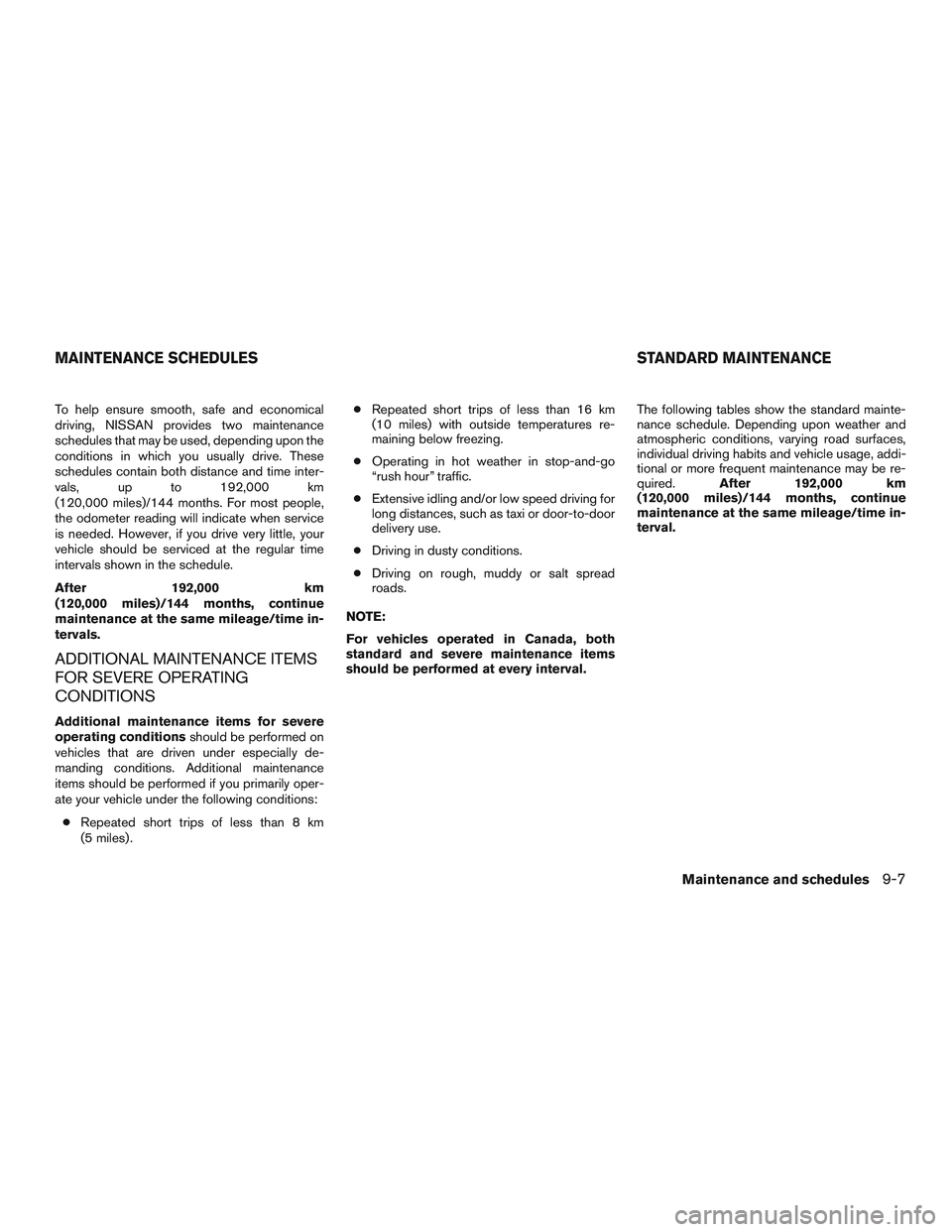
To help ensure smooth, safe and economical
driving, NISSAN provides two maintenance
schedules that may be used, depending upon the
conditions in which you usually drive. These
schedules contain both distance and time inter-
vals, up to 192,000 km
(120,000 miles)/144 months. For most people,
the odometer reading will indicate when service
is needed. However, if you drive very little, your
vehicle should be serviced at the regular time
intervals shown in the schedule.
After 192,000 km
(120,000 miles)/144 months, continue
maintenance at the same mileage/time in-
tervals.
ADDITIONAL MAINTENANCE ITEMS
FOR SEVERE OPERATING
CONDITIONS
Additional maintenance items for severe
operating conditionsshould be performed on
vehicles that are driven under especially de-
manding conditions. Additional maintenance
items should be performed if you primarily oper-
ate your vehicle under the following conditions:
● Repeated short trips of less than 8 km
(5 miles) . ●
Repeated short trips of less than 16 km
(10 miles) with outside temperatures re-
maining below freezing.
● Operating in hot weather in stop-and-go
“rush hour” traffic.
● Extensive idling and/or low speed driving for
long distances, such as taxi or door-to-door
delivery use.
● Driving in dusty conditions.
● Driving on rough, muddy or salt spread
roads.
NOTE:
For vehicles operated in Canada, both
standard and severe maintenance items
should be performed at every interval. The following tables show the standard mainte-
nance schedule. Depending upon weather and
atmospheric conditions, varying road surfaces,
individual driving habits and vehicle usage, addi-
tional or more frequent maintenance may be re-
quired.
After 192,000 km
(120,000 miles)/144 months, continue
maintenance at the same mileage/time in-
terval.
MAINTENANCE SCHEDULES STANDARD MAINTENANCE
Maintenance and schedules9-7
Page 282 of 318

MAINTENANCE OPERATION
Perform at number of kilometers, miles or months, whichever comes first. km x 1,000
(miles x 1,000) Months MAINTENANCE INTERVAL
104
(65) 78 112
(70) 84 120
(75) 90 128
(80) 96 136
(85) 102 144
(90) 108 152
(95) 114 160
(100) 120 168
(105) 126 176
(110) 132 184
(115) 138 192
(120) 144
Drive belts See NOTE (1)I*I*I*I*I*I*
Air cleaner filter See NOTE (2) RR
Engine oil RRRRRRRRRRRR
Engine oil filter RRRRRRRRRRRR
Engine coolant* See NOTE (4)(5)
EVAP vapour lines I*I*I*
Fuel lines I*I*I*
Fuel filter See NOTE (3)
Spark plugs (Iridium - tipped type) See NOTE (6)Replace every 168,000 km (105,000 miles)
Intake and exhaust valve clearances See NOTE (7)
NOTE:
(1) After 64,000 km (40,000 miles) or 48 months, inspect every 16,000 km (10,000 miles) or 12 months. Replace the drive belts if found damaged.
(2) If operating mainly in dusty conditions, more frequent maintenance may be required.
(3) Periodic maintenance is not required.
(4) First replacement interval is 168,000 km (105,000 miles) or 84 months. After first replacement, replace every 120,000 km (75,000 miles) or 60 months.
(5) Use only Genuine NISSAN Long Life Antifreeze/Coolant (blue) or equivalent with proper mixture ration of 50% antifreeze and 50% demineralized or
distilled water. Mixing any other type of coolant or the use of non-distilled water may reduce the life expectancy of the factory fill coolant.
(6) For MRA8DE:
Replace spark plug when the plug gap exceeds 1.35 mm (0.053 in) even within specified periodic replacement mileage.
For MR16DDT:
Replace spark plug when the plug gap exceeds 1.1 mm (0.043 in) even within specified periodic replacement mileage.
(7) Periodic maintenance is not required. However, if valve noise increased, inspect valve clearance.
* Maintenance items and intervals with “*” are recommended by NISSAN for reliable vehicle operation. The owner need not perform such
maintenance in order to maintain the emission warranty or manufacturer recall liability. Other maintenance items and intervals are required.
Maintenance and schedules9-9
Page 286 of 318
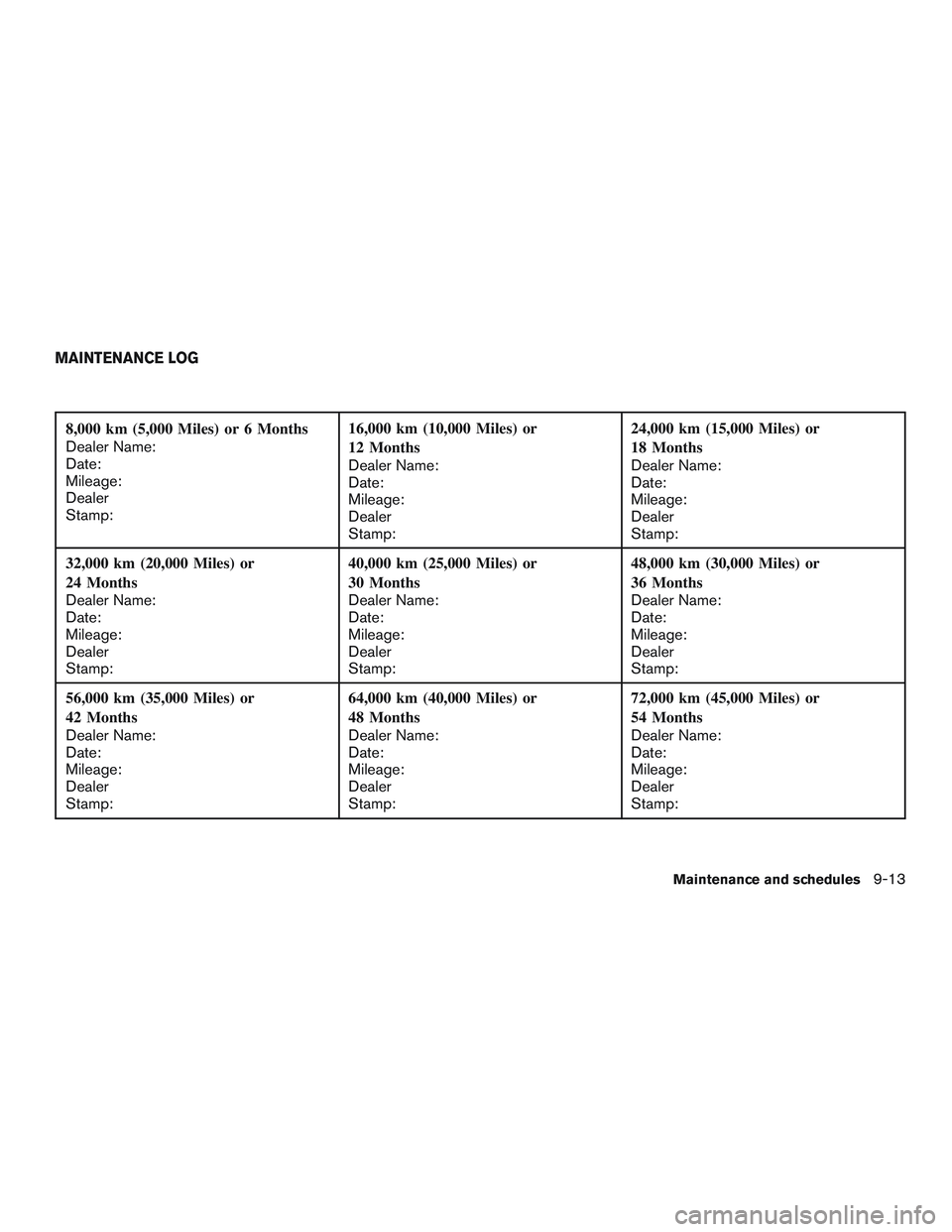
8,000 km (5,000 Miles) or 6 Months
Dealer Name:
Date:
Mileage:
Dealer
Stamp:16,000 km (10,000 Miles) or
12 Months
Dealer Name:
Date:
Mileage:
Dealer
Stamp:24,000 km (15,000 Miles) or
18 Months
Dealer Name:
Date:
Mileage:
Dealer
Stamp:
32,000 km (20,000 Miles) or
24 Months
Dealer Name:
Date:
Mileage:
Dealer
Stamp: 40,000 km (25,000 Miles) or
30 Months
Dealer Name:
Date:
Mileage:
Dealer
Stamp:48,000 km (30,000 Miles) or
36 Months
Dealer Name:
Date:
Mileage:
Dealer
Stamp:
56,000 km (35,000 Miles) or
42 Months
Dealer Name:
Date:
Mileage:
Dealer
Stamp: 64,000 km (40,000 Miles) or
48 Months
Dealer Name:
Date:
Mileage:
Dealer
Stamp:72,000 km (45,000 Miles) or
54 Months
Dealer Name:
Date:
Mileage:
Dealer
Stamp:
MAINTENANCE LOG
Maintenance and schedules9-13
Page 287 of 318
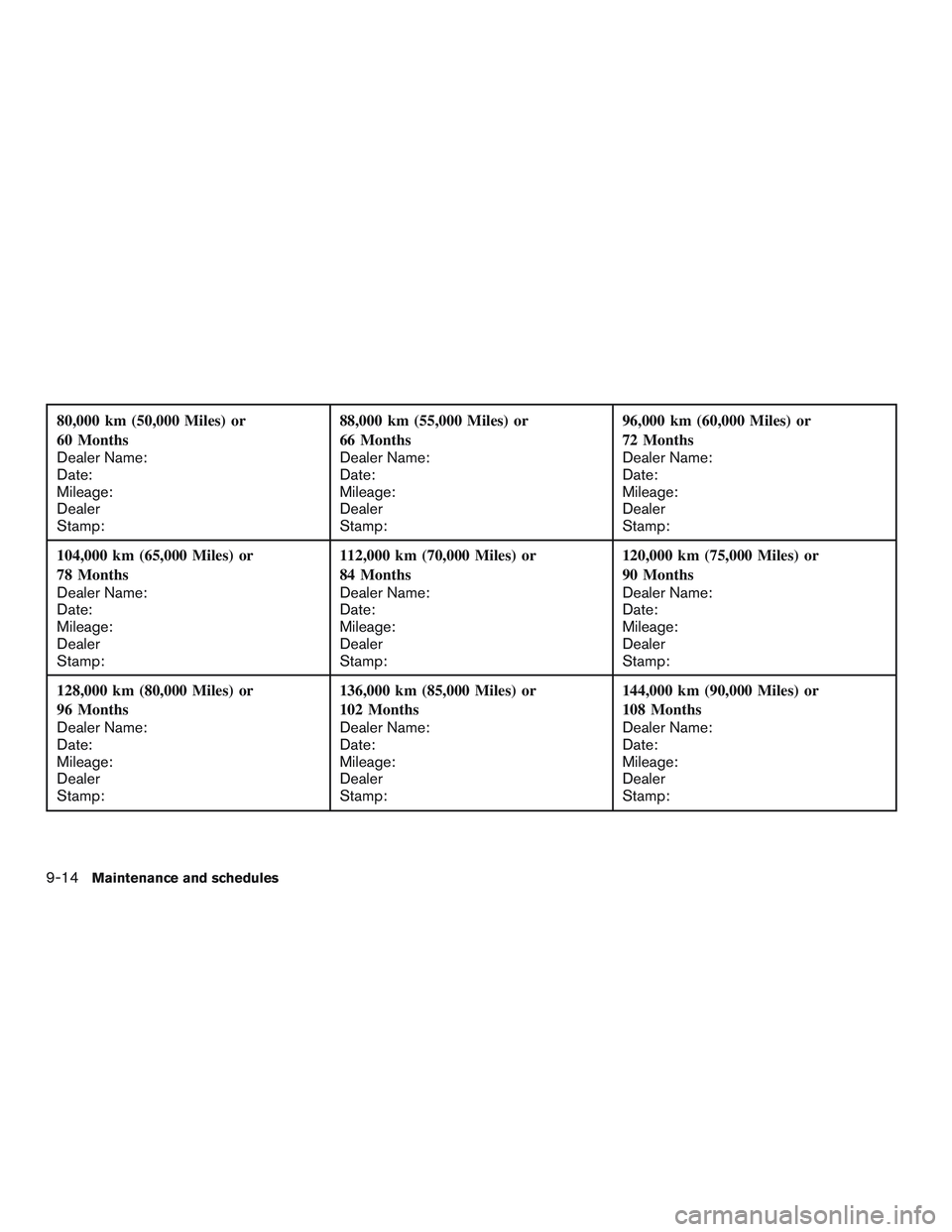
80,000 km (50,000 Miles) or
60 Months
Dealer Name:
Date:
Mileage:
Dealer
Stamp:88,000 km (55,000 Miles) or
66 Months
Dealer Name:
Date:
Mileage:
Dealer
Stamp:96,000 km (60,000 Miles) or
72 Months
Dealer Name:
Date:
Mileage:
Dealer
Stamp:
104,000 km (65,000 Miles) or
78 Months
Dealer Name:
Date:
Mileage:
Dealer
Stamp: 112,000 km (70,000 Miles) or
84 Months
Dealer Name:
Date:
Mileage:
Dealer
Stamp:120,000 km (75,000 Miles) or
90 Months
Dealer Name:
Date:
Mileage:
Dealer
Stamp:
128,000 km (80,000 Miles) or
96 Months
Dealer Name:
Date:
Mileage:
Dealer
Stamp: 136,000 km (85,000 Miles) or
102 Months
Dealer Name:
Date:
Mileage:
Dealer
Stamp:144,000 km (90,000 Miles) or
108 Months
Dealer Name:
Date:
Mileage:
Dealer
Stamp:
9-14
Maintenance and schedules
Page 288 of 318
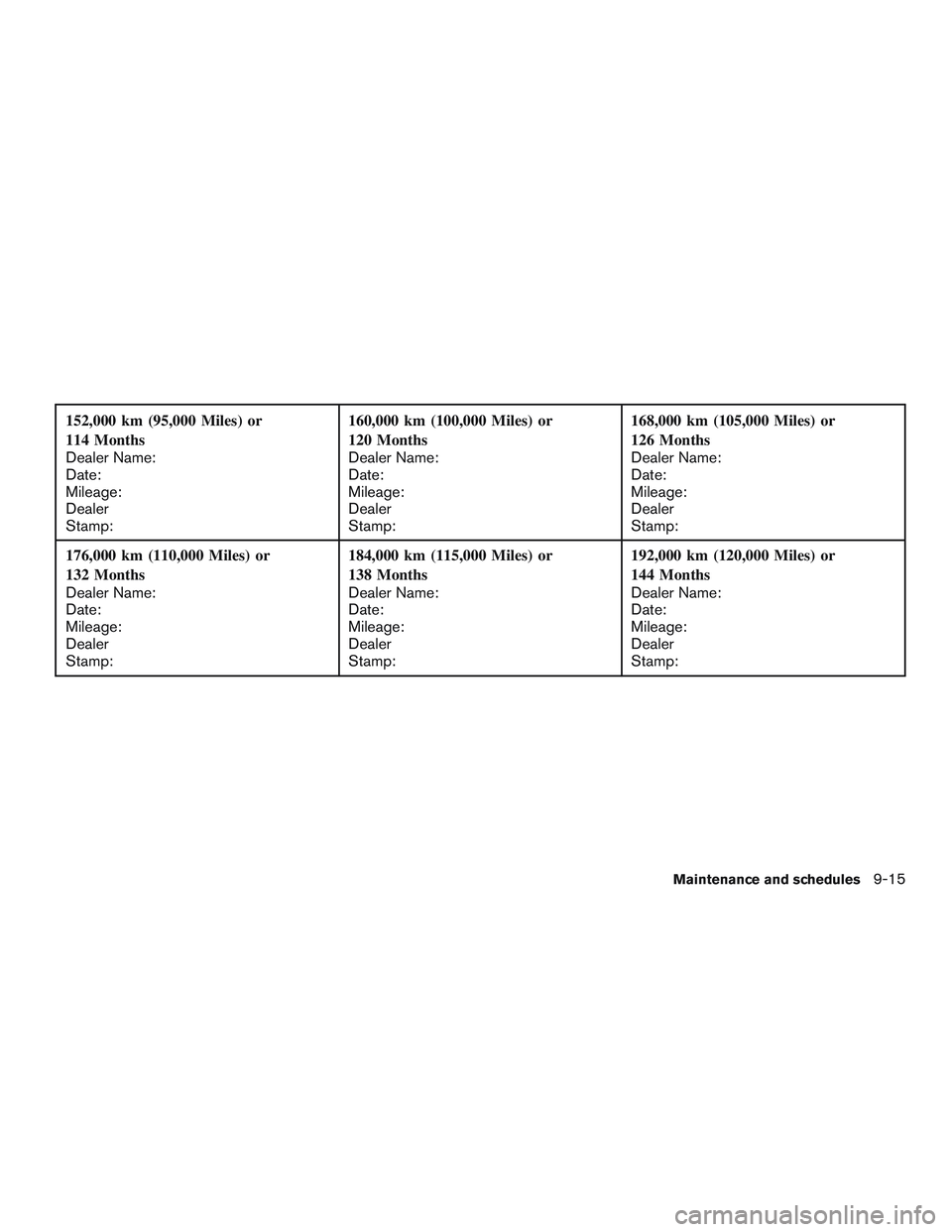
152,000 km (95,000 Miles) or
114 Months
Dealer Name:
Date:
Mileage:
Dealer
Stamp:160,000 km (100,000 Miles) or
120 Months
Dealer Name:
Date:
Mileage:
Dealer
Stamp:168,000 km (105,000 Miles) or
126 Months
Dealer Name:
Date:
Mileage:
Dealer
Stamp:
176,000 km (110,000 Miles) or
132 Months
Dealer Name:
Date:
Mileage:
Dealer
Stamp: 184,000 km (115,000 Miles) or
138 Months
Dealer Name:
Date:
Mileage:
Dealer
Stamp:192,000 km (120,000 Miles) or
144 Months
Dealer Name:
Date:
Mileage:
Dealer
Stamp:
Maintenance and schedules9-15